Choosing Playmates for your Dog
It's always fun to take your dog to the dog park or to a doggie daycare, but how do you know if your dog will be safe from the other dogs there? What if your dog is the one who is endangering other dogs?
Size Matters
One of the first things you should consider when choosing a playmate for your dog is the relative size and strength of the two dogs. Small dogs have very often been hurt or even killed by playing with older, stronger dogs, even though no ill intent was present. Larger dogs, particularly when they are puppies, do not often realize their own strength. And very few small dogs understand that they are small and thus, somewhat fragile.
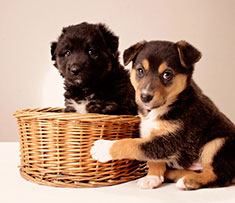
The mark of a dog park or daycare that has safety in mind is that the facility has separate areas for large and small dogs. There should be clear signage indicating which area is for whom, and there should be some method of enforcement for guardians who aren't considerate enough to obey the posted signs. An alternate plan is to allow small dogs to attend only on specific days and large dogs to attend on alternate days.
Why do dogs fight?
Dogs are, at their cores, pack animals, and in every pack there is a leader. The problem arises when more than one dog thinks the leadership post is not yet decided. Although certain dog breeds are known to have more aggressive tendencies than others, any dog can become aggressive given the proper circumstances.
Common issues leading to aggression include food, toys, and women. (Sounds like humans, doesn't it?) In a typical wild pack, the alpha dog would have first choice of the food regardless of who killed the prey animal, and the alpha dog would have first choice of mates. In some cases, the other dogs might not even be allowed to mate with any of the females in the pack, as the genetic make-up of the leader would be seen as the strongest and best chance for survival of the pack.
Now that dogs have been domesticated, these issues have not necessarily gone away. It is only through consistent training and socialization that dogs are able to overcome, or at least deal peacefully with, the pack mentality.
Signs of aggression
In order to see if a dog might be a prospective good match as a playmate for your dog, you will need to be able to identify any signs of aggression or dominance in either dog. The cardinal signs of aggression are:
- Tension of the body
- Mounting or humping
- Leaning forward when standing
- Raised lips / wrinkled muzzle
- Growling
- Raising of the hackles, the fur on the back
- Leaning forward when standing
- Lunging
- Biting
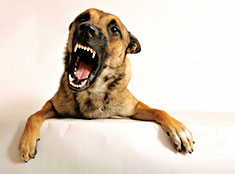
Introducing new dogs to each other
The safest way to introduce two new dogs to each other is through a chain-link fence. Allow the dogs to approach each other from opposite sides of a fence, preferably with neither dog on a leash. Watch both dogs for signs of aggression and for signs of fear such as backing away from the other dog.
In a "normal" encounter, the two dogs will approach each other with tails held high, noses sniffing each other, either in the face or in the rump. The dogs will typically be excited, but not fearful or aggressive.
In some cases, a dog may immediately surrender the dominant position in the pack to another dog by simply rolling over onto his or her back in a submissive posture. There will not likely be problems between the two dogs if one dog makes it abundantly obvious that he or she has no interest in the leadership position.
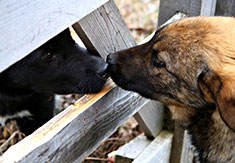
Temperament testing basics
A more formal method of testing dogs' personalities is done by means of a temperament test. If you are considering enrolling your dog in a daycare setting, you might want to ask if the center does temperament testing. It can be a good indication of which dogs will do well together, and at least should weed out those dogs who are too aggressive to succeed in a group play setting.
According to the Partnership for Animal Welfare paw-rescue.org in Washington, DC, a dog's temperament can be defined as "the general attitude a dog displays towards people and other animals; it is the combined inherited and acquired physical and mental traits that influence the dog's behavior." Testing is used to "measure traits including stability, confidence, shyness, friendliness, aggressiveness, protectiveness, prey instincts, play drive, and self-defense instincts, and ability to distinguish between threatening and nonthreatening situations."
When testing a dog, it is important that the tester have a good history of the dog including any past aggression and the circumstances under which the dog has lived such as past abuse or neglect. The dog should wear a sturdy collar during testing so that the tester can control the dog if necessary, and a spotter should be present for observation and additional safety and control if needed. Testing should be done in a quite area, removed from other dogs and interruptions.
Specific temperament tests
The things that are usually tested for include sociability, reaction to certain stimuli such as sudden movement, unfamiliar objects, noises, and other animals, leash skills, trainability, personality traits including shyness, activity level, dependence, and food or toy possessiveness.
Although there are several specific protocols used for testing (see links below), most include some variation of the following elements.
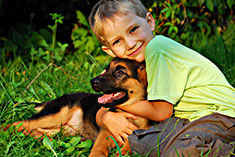
1. How long does it take the dog to pay attention to the evaluator?
2. Does the dog come when called?
3. How does the dog react when the evaluator approaches and makes eye contact or stares at the animal?
4. Does the dog tolerate petting? Hugging?
5. Does the dog panic or investigate when presented with new objects and noises?
6. Does the dog allow the evaluator to coax him or her into lying down?
7. How does the dog react when the evaluator leaves the room?
8. Is the dog interested in playing with the evaluator?
9. Will the dog release a toy the evaluator tries to take away from him or her?
10. Does the dog chase other animals? (This is done under controlled conditions such as allowing the dog to see a cat or a small animal through a glass wall to gauge the dog's reactions.)
11. Does the dog take a treat nicely from the evaluator's hand? Does he tolerate a treat or bone being taken back after having been given?
12. How does the dog react to praise and affection?
All of the following web sites will give you ideas you might use when assessing the temperament of potential playmates for your dog.
Assessing a Shelter Dog by Jean M. Fogle shelterdogs.org
Evaluating Temperament in a Potential Rescue Dog by M. Shirley Chong shibaweb.com
Assess-A-Pet Program by Sue Sternberg suesternberg.com
Puppy Aptitude Test by Wendy and Joachim Volhard workingdogs.com
Temperament Testing Program at C.A.R.E. Sheltercare-evanston.org
Matching Dogs and People: Temperament Testing Shelter Dogs canismajor.com
American Temperament Test Society atts.org
Tough Temperaments: Dominance, Aggression, Viciousness and definitions of other terms such as Submission, Temperament, Socialization canismajor.com
Fostering a Rescue Dog shibaweb.com
Canine Drivescanismajor.com
Choosing and Getting a Dog paw-rescue.org
Adding a Dog to Your Family: How to Prepare for Success Mixed Breedes paw-rescue.org
Doggies Den: Latest Articles
 Homemade Thanksgiving Treats for Your Dog
Homemade Thanksgiving Treats for Your Dog
NUTRITION We all want to include our dogs in our holiday celebrations, but hopefully, you're aware that sharing table scraps with your dog isn't always the best idea.
 Keeping Your Dog Safe during the Summer Months
Keeping Your Dog Safe during the Summer Months
HEALTH Summer is coming on fast, so it’s time to plan how you will keep your dog safe and healthy through the lazy, carefree, warm days.
 Vaccination Time Again-Keeping Your Puppy Healthy
Vaccination Time Again-Keeping Your Puppy Healthy
DOG HEALTH So you have your new puppy picked out. There are quite a few shots, treatments and examinations that will keep the newest member of your family healthy.
 Canine Thanksgiving Feast
Canine Thanksgiving Feast
NUTRITION With the wide variety of food at Thanksgiving dinner, chances are you'll want to give your dog something special, too. If you're contemplating what to feed your dog for the holiday, here is a guide to a great Canine Thanksgiving Feast.
 Dog Walking Tips Every Owner Should Know
Dog Walking Tips Every Owner Should Know
DOG FUN Walking your dog is not only crucial to keeping him healthy and happy, it strengthens the bond between your canine friend and his caregiver. There are a lot of obstacles out there. Don’t forget these simple tips to keep your walk fun and safe in the outside world.
 The Benefits of Physiotherapy for your Dog
The Benefits of Physiotherapy for your Dog
HEALTH The same techniques that physiotherapists use to treat a variety of injuries and conditions in humans have been adapted to suit animals with great success. Family pets, show dogs, and working dogs can all benefit greatly from physiotherapy. Dogs whose activities involve a lot of agility are especially susceptible to the types of problems that physiotherapy can address.
 The Decision- Adding a Dog to Your Family
The Decision- Adding a Dog to Your Family
FIRST TIME OWNERSBringing a dog into your family is a decision where many people don’t realize it’s magnitude until after they have the dog. There are a number of things that you need to research before you decide to purchase a dog, and it starts right in your own home.
 Bringing Your Dog Into Your New Baby's Life
Bringing Your Dog Into Your New Baby's Life
HEALTH Many believe that a dog and a new baby cannot happily coexist, so therefore the dog has to go. This is not necessarily the case. A new baby does not mean you have to abandon your dog.

Doggies Den:
Most Popular Articles

Dog Pregnancy Symptoms
HEALTHIf you suspect your dog might be pregnant, check out part one in this series on pregnant dogs, where we cover pregnant dog symptoms.
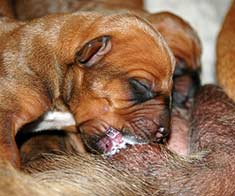
Dog Birth
HEALTHIn the third article of our dog pregnancy series, we look at the wonderful, but messy, process of bringing newborn puppies into the world.

Indoor Dog Potties
DOG PRODUCTSIt's been a long day at work. You were so busy, you didn't even take time to eat a sandwich, let alone run home to let your dog out. You're on your way home, knowing the poor dog is crossing his or her legs by now, when your car breaks down, delaying you even further. Can't somebody make this easier?

Your Dog’s Digestive System
PHYSIOLOGYEver wonder why your dog eats so fast? Or why he eats gross things? Or why he gets sick to his stomach? Or why his waste stinks so bad? Some of these things are normal, some are not.

Canine Respiratory System
BREATHINGThe basic function of your dog's respiratory system is to bring oxygen in to and remove carbon dioxide from the body. Knowing the symptoms of respiratory diseases can help you help your stay healthy.
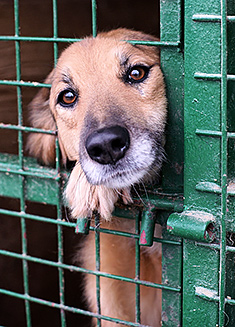
Shelter Dog Adoption Tips for Success
ADOPTION Are you intimidated by the prospect of "rescuing" a dog from a shelter? One reason that you may be wary of adopting a dog from a shelter is not knowing how to choose. Adopting a dog from a shelter can be a rewarding process, if you're prepared to do a reasonable amount of research.

Canine Urinary Tract Infections
SYMPTOMS AND TREATMENTDoes your dog seem to be having trouble relieving his or her bladder? Learn how to recognize the signs of urinary tract infections and how to treat them before they spread.

What to do for Dog Diarrhea
SYMPTOMS AND REMEDIESIf you have dogs in your house for any length of time, you have likely experienced at least one bout of dog diarrhea. Beyond the pain in the tuckus involved in cleaning up the mess, you should know what causes diarrhea, and when it's important to see the vet.

What to do for a Dog Bite
DOG BEHAVIOR Getting bitten by a dog can be scary, and you may be tempted to run around in circles for a while, trying to figure out what to do. Here's our guide to help you manage the situation.

Top Ten Tips for Living with a Senior Dog
DOG HEALTH Bringing home a new puppy is so exciting, but it doesn’t take all that long for your exuberant puppy to grow into a senior dog who may have special needs. Here are the doggies.com top ten tips for taking care of your companion who has been with you through so much.
